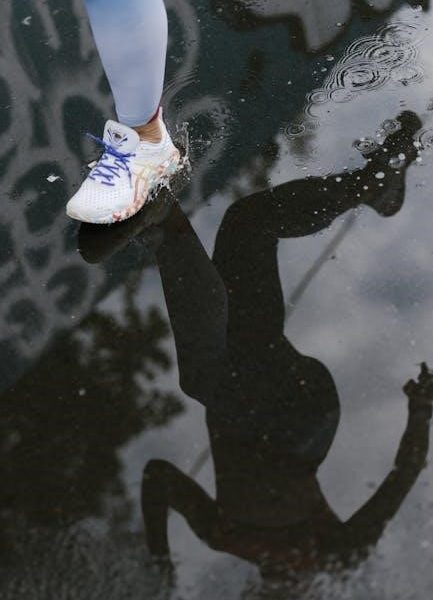
marathon guide oregon
Oregon offers a diverse range of marathons, from urban races like the Portland Marathon to scenic trail runs, attracting runners with its natural beauty and supportive communities.
1.1 Popular Marathon Events in Oregon
Oregon hosts several iconic marathons, including the Portland Marathon, known for its flat, fast course and scenic views of the Willamette River. The Eugene Marathon, held in TrackTown USA, attracts runners with its historic significance and community support. The Vernonia Marathon offers a peaceful, forested trail experience, while the Hood to Coast Relay provides a unique team-based endurance challenge. These events showcase Oregon’s diverse landscapes and vibrant running culture.
1.2 Why Oregon is a Favorite for Runners
Oregon’s natural beauty, diverse landscapes, and year-round mild climate make it a runner’s paradise. From the scenic coastal trails to the serene forests and urban pathways, the state offers endless opportunities for runners to connect with nature. Additionally, Oregon’s vibrant running communities, well-organized events, and runner-friendly infrastructure, such as bike lanes and parks, contribute to its appeal. The state’s culture of health and wellness further supports runners’ lifestyles and training goals.
Training for a Marathon
Training for a marathon requires a structured plan, starting with building a base fitness level, incorporating rest, and focusing on mental preparation and goal setting.
2.1 Building a Base Fitness Level
Building a base fitness level is crucial for marathon training. Start with consistent weekly mileage, gradually increasing over time to avoid injury. Incorporate a mix of running, cross-training, and strength exercises to enhance endurance and overall fitness. Aim for at least 3-4 hours of aerobic activity per week, with one longer run to build stamina. Oregon’s running communities and scenic trails provide ideal settings for this foundational phase, ensuring a strong start to your marathon journey.
2.2 Creating a Structured Training Plan
A well-structured training plan is essential for marathon success. Start with periodized training, balancing endurance runs, speed workouts, and recovery. Oregon’s scenic routes offer ideal settings for varied runs; Include long runs to build stamina, interval training for speed, and rest days for recovery. Use online tools or consult coaches to tailor plans to your goals and fitness level, ensuring progressive overload to avoid plateaus and injuries. Consistency and adaptability are key to a successful plan.
2.3 Incorporating Rest and Recovery
Rest and recovery are crucial for marathon training. Ensure adequate sleep, 7-9 hours nightly, to aid muscle repair. Incorporate rest days or cross-training, such as cycling or swimming, to reduce injury risk. Oregon’s natural hot springs and massage therapists offer recovery options. Use foam rollers and ice baths to relieve muscle tension. Listen to your body and adjust training to avoid overtraining, ensuring peak performance on race day and long-term health.
2.4 Mental Preparation and Goal Setting
Mental preparation is vital for marathon success. Set SMART (Specific, Measurable, Achievable, Relevant, Time-bound) goals to stay motivated. Practice visualization techniques to build confidence and resilience. Break larger goals into smaller, manageable steps to maintain consistency. Track progress and celebrate milestones to stay motivated. Oregon’s scenic routes and supportive communities provide inspiration, helping runners stay focused and mentally strong throughout their training journey.
Oregon Marathon Courses
Oregon’s marathon courses offer diverse terrain, from urban streets to scenic trails, providing runners with unique challenges and breathtaking views that highlight the state’s natural beauty.
3.1 Overview of the Course Terrain
Oregon’s marathon courses feature diverse terrain, including urban roads, scenic trails, and coastal routes. Runners encounter flat stretches, gradual inclines, and occasional hills, testing endurance. The state’s natural beauty, with lush forests, river valleys, and ocean views, creates a unique and inspiring experience. Courses like the Willamette Valley’s rolling vineyards and the Columbia River Gorge’s dramatic landscapes highlight Oregon’s varied and picturesque environments, appealing to runners seeking both challenge and scenic reward.
3.2 Scenic Routes and Landmarks
Oregon’s marathons often feature breathtaking scenic routes, showcasing the state’s natural beauty. Courses frequently pass through iconic landmarks like the Columbia River Gorge, offering stunning views of cliffs and waterfalls. Coastal routes, such as those in Cannon Beach, provide runners with oceanfront paths and glimpses of landmarks like Haystack Rock. Urban marathons, like the Portland Marathon, highlight the city’s vibrant neighborhoods and parks, blending natural charm with cityscapes.
3.3 The Role of Spectators and Support
Spectators play a vital role in Oregon marathons, providing encouragement and creating a lively atmosphere. Many courses, like the Vernonia Marathon, draw around 200 spectators who cheer runners along scenic routes. Supporters often use cowbells, signs, and chants to boost morale. Organizers encourage spectators to familiarize themselves with the course to maximize their impact. Aid stations and designated cheering zones further enhance the supportive environment, making runners feel motivated and connected to the community throughout the race.

Weather and Climate Considerations
Oregon’s marathons often experience variable weather, with rainy or sunny conditions. Runners should prepare for both, wearing layers and staying hydrated to adapt to changing climates.
4.1 Average Weather Conditions During Marathon Season
Oregon’s marathon season typically features mild temperatures, ranging from 45°F to 65°F, with occasional rain. Spring and fall races may experience overcast skies, while summer events can see sunshine. Runners should prepare for variable conditions, including wind and potential rainfall. Staying hydrated and dressing in layers are essential to adapt to Oregon’s unpredictable climate during marathon season.
4.2 Preparing for Rainy or Sunny Conditions
Runners should be ready for Oregon’s variable weather. For rain, wear breathable, waterproof clothing and consider a lightweight jacket. In sunny conditions, opt for light, moisture-wicking fabrics and don’t forget sunscreen. Stay hydrated in both scenarios, and adjust your gear based on the forecast. Visibility is key in rain, so use reflective accessories. Proper footwear with traction can handle wet surfaces, ensuring a safe and comfortable race experience regardless of the weather.

Marathon Logistics
Plan ahead with early registration, secure accommodations near the start line, and pack essentials like bibs, timing chips, and nutrition. Check weather forecasts and transport options to ensure a smooth race day experience in Oregon.
5.1 Registration Process and Deadlines
Registering for Oregon marathons typically involves an online process with deadlines varying by event. Popular races like the Portland Marathon often close registration months in advance due to high demand. Be sure to check the official website for specific dates, as missing deadlines may result in late fees or denial of entry. Early registration is recommended to secure your spot and receive event updates.
5.2 Travel and Accommodation Tips
Plan your travel and lodging well in advance, especially for popular marathons like the Portland Marathon. Book hotels near the start/finish lines to minimize race-day stress. Consider renting a car if the marathon is in a remote area. Check for local transportation options or shuttle services provided by race organizers. For smaller towns hosting marathons, lodging options may be limited, so reserve early to ensure availability. Explore nearby attractions to enjoy Oregon’s scenic beauty before or after the race.
5.3 Race Day Essentials and Checklist
Pack essentials like your race bib, timing chip, comfortable attire, and proper footwear. Bring a government-issued ID for verification. Hydration and nutrition supplies, such as water bottles or energy gels, are crucial. Plan race morning nutrition carefully to avoid stomach discomfort. Arrive early to account for parking and baggage check. Carry a light jacket or disposable layer for pre-race warmth. Don’t forget sun protection, such as sunscreen or a hat. Keep a small first-aid kit and a fully charged phone handy. Create a checklist to ensure nothing is missed.
Health and Nutrition
Proper nutrition is vital for marathon performance. Focus on balanced meals rich in carbohydrates, proteins, and healthy fats. Stay hydrated to maintain energy levels and prevent fatigue.
6.1 Proper Nutrition for Marathon Training
A balanced diet is essential for marathon training. Focus on complex carbs like whole grains, lean proteins such as chicken or fish, and healthy fats from nuts or avocados. Hydration is key to avoid dehydration and maintain energy levels. Aim to eat meals rich in fiber and vitamins, while avoiding processed foods that can cause digestive issues. Proper nutrition supports endurance, recovery, and overall performance during training and on race day.
6.2 Hydration Strategies
Proper hydration is crucial for marathon training. Aim to drink 8-10 glasses of water daily, adjusting for sweat loss. Calculate fluid needs by weighing before and after runs. Drink 16-20 ounces of water 1-2 hours pre-run and 7-10 ounces every 10-15 minutes during training. Avoid overhydration by monitoring urine color and balancing electrolytes. Ensure hydration is consistent and tailored to Oregon’s varying weather conditions to maintain optimal performance and prevent dehydration or hyponatremia.
6.3 Injury Prevention and Management
Injury prevention is key for marathon success. Incorporate strength training to build resilience, and ensure proper footwear. Listen to your body, rest when needed, and gradually increase mileage. Address minor aches early with ice baths, stretching, and foam rolling. Stay hydrated and fueled to prevent fatigue-related injuries. Consult professionals for persistent issues to avoid setbacks. Prioritize recovery to maintain consistency and peak performance during training and the race.

Community and Support
Oregon’s vibrant running community offers strong support through local clubs, volunteer opportunities, and spectator encouragement, fostering motivation and camaraderie for runners of all levels.
7.1 Local Running Clubs and Groups
Oregon is home to numerous running clubs and groups that provide invaluable support to marathon runners. Clubs like the Portland Running Company and Eugene Running Club organize regular group runs, training sessions, and workshops. These communities foster camaraderie, offer expert advice, and help runners stay motivated throughout their training journey. Joining a local running group is an excellent way to connect with fellow runners and enhance your marathon preparation.
7.2 Volunteering and Spectator Opportunities
Oregon marathons offer ample opportunities for volunteering and spectating, fostering a vibrant community spirit. Volunteers can assist at water stations, course marshaling, or event registration, while spectators cheer runners along scenic routes. Many races, like the Portland Marathon, encourage supporters to create lively cheer zones, enhancing the overall experience. Volunteering or spectating is a great way to engage with the running community and contribute to the success of these events.

Race Etiquette and Safety
Respect personal space, follow course rules, and stay alert. Ensure hydration and energy needs are met, and be prepared for emergencies with a clear communication plan in place.
8.1 Understanding Marathon Etiquette
Marathon etiquette ensures a respectful and enjoyable experience for all participants. Key principles include staying in designated lanes, avoiding sudden movements, and not blocking others. Always be mindful of aid station protocols, such as not littering or cutting off volunteers. Respecting fellow runners, whether faster or slower, fosters a positive community atmosphere. Adhering to course rules and being prepared for the event are essential for a safe and fair race environment.
8.2 Safety Tips for Runners
Safety is paramount for runners. Always wear reflective gear and stay alert to surroundings, especially on shared roads. Carry identification and ensure someone knows your route and expected return time. Stay hydrated and listen to your body to avoid overexertion. Be visible to drivers by facing traffic and using crosswalks. Avoid distractions like headphones in busy areas and follow all traffic signals. Plan for emergencies with a phone or safety device.
Leave a Reply
You must be logged in to post a comment.